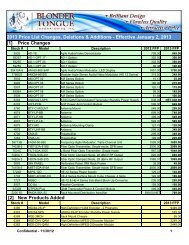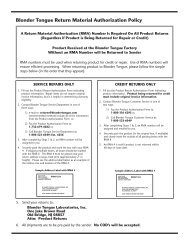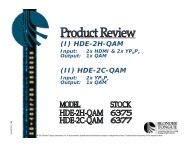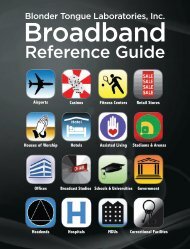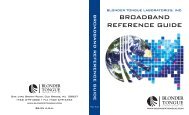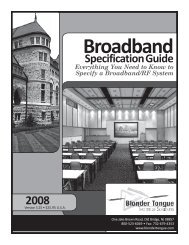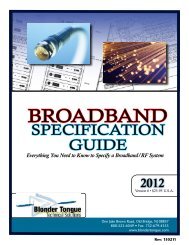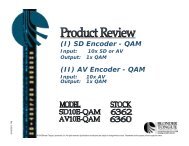US Digital Transition - Blonder Tongue Laboratories Inc.
US Digital Transition - Blonder Tongue Laboratories Inc.
US Digital Transition - Blonder Tongue Laboratories Inc.
Create successful ePaper yourself
Turn your PDF publications into a flip-book with our unique Google optimized e-Paper software.
3. Terminology - Television Standards<br />
Commercially-made television sets, or TVs, have been available since 1928. And although TVs today use various display technologies such as CRT<br />
(Cathode Ray Tube), LCD (Liquid Crystal Display), or PDP (Plasma Display Panel, or Plasma), they all can be classified into two basic types, namely<br />
Analog TV and <strong>Digital</strong> TV.<br />
3.1 Analog TV<br />
An analog TV is equipped with an anlog tuner and is capable of displaying video and sound information received in an analog<br />
format only. In North America, that analog format must adhere to the NTSC standard discussed previoulsy. Analog TVs typically<br />
ulitize a CRT display with a screen width-to-height ratio of 4:3. Per FCC mandate, televisions sold in the <strong>US</strong> after May 25, 2007<br />
should contain a digital tuner (also known as ATSC tuner) compatible with the 8VSB standard (<strong>Digital</strong> Off-Air), or should be<br />
identified at the point-of-sale as not having one.<br />
3<br />
4<br />
3.2 <strong>Digital</strong>-Ready TV<br />
Not exactly a <strong>Digital</strong> TV, nor exactly an Analog TV, <strong>Digital</strong>-Ready TVs are typically an Analog TV equipped with an internal digital<br />
tuner (ATSC tuner). A digital-ready TV can receive and display analog and digital off-air programs without the need for an external<br />
8VSB-to-analog converter box. To ensure that a TV set is equipped with digital/ATSC tuner you should consult its user manual or<br />
manufacturer’s documentation. However, most digital-ready TVs are marketed with labels such as “Integrated <strong>Digital</strong> Tuner” or<br />
“<strong>Digital</strong> Tuner Built-In.” In some cases, the word “Receiver” may be substituted for “Tuner”. In other cases, the words “DTV”, ATSC”,<br />
or “HDTV” may be substituted for “<strong>Digital</strong>.” Most digital-ready TVs have a display aspect ratio of 4:3.<br />
3<br />
4<br />
3.3 <strong>Digital</strong> TV<br />
A digital TV is equipped with an analog tuner, a digital/ATSC tuner, and a QAM (<strong>Digital</strong> Cable) tuner. <strong>Digital</strong> TV sets typically ulitize an LCD or Plasma display and are<br />
classified, based on their display resolution, as an SDTV (Standard-Defintion Television) or HDTV (High-Definition Television).<br />
SDTV: A digital TV capable of displaying 480 actively-interlaced vertical lines of resolution is usually considered an SDTV. As such, an<br />
SDTV is also known as a “480i” set. A typical SDTV has a display aspect ratio of 4:3, and a resolution of 720x480 (345,600 pixels).<br />
HDTV: A digital TV set capable of displaying at least 720 vertical lines of resolution is usually considered a HDTV. A typical HDTV has a<br />
display aspect ratio of 16:9 and is available in the following video formats and display resolutions:<br />
Video Display Resolution Displayed Pixels<br />
720p 1280 x 720 Progressively-Scanned Lines 921,600<br />
1080i 1280 x 1080 Actively-Interlaced Lines 1,382,400<br />
1080p 1920 x 1080 Progressively-Scanned Lines 2,073,600<br />
9<br />
16<br />
<strong>Blonder</strong> <strong>Tongue</strong> <strong>Laboratories</strong>, <strong>Inc</strong>.<br />
1.800.523.6049 www.blondertongue.com<br />
Slide # 5



